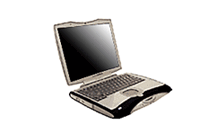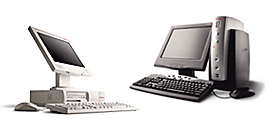|
Generally, a computer is any device that can perform numerical calculations even an adding machine, an abacus, or a slide
rule. Currently, however, the term usually refers to an electronic device that can use a list of instructions, called a program,
to perform calculations or to store, manipulate, and retrieve information.
Today's computers are marvels of miniaturization.
Machines that once weighed 30 tons and occupied warehouse-size rooms now may weigh as little as three pounds (1.4 kilograms)
and can be carried in a suit pocket. The heart of today's computers are integrated circuits (ICs), sometimes called microchips,
or simply chips. These tiny silicon wafers can contain millions of microscopic electronic components and are designed for
many specific operations: some control an entire computer (CPU, or central processing unit, chips); some perform millions
of mathematical operations per second (math coprocessors); others can store more than 16 million characters of information
at one time (memory chips).
In 1953 there were only about 100 computers in use in the entire world. Today hundreds
of millions of computers form the core of electronic products, and more than 110 million programmable computers are being
used in homes, businesses, government offices, and universities for almost every conceivable purpose.
Computers come
in many sizes and shapes. Special-purpose, or dedicated, computers are designed to perform specific tasks. Their operations
are limited to the programs built into their microchips. These computers are the basis for electronic calculators and can
be found in thousands of other electronic products, including digital watches (controlling timing, alarms, and displays),
cameras (monitoring shutter speeds and aperture settings), and automobiles (controlling fuel injection, heating, and air conditioning
and monitoring hundreds of electronic sensors).
General-purpose computers, such as personal computers and business
computers, are much more versatile because they can accept new sets of instructions. Each new set of instructions, or program,
enables the same computer to perform a different type of operation. For example, one program lets the computer act like a
word processor, another lets it manage inventories, and yet another transforms it into a video game.
Although some
general-purpose computers are as small as pocket radios, the smallest class of fully functional, self-contained computers
is the class called notebook computers. These usually consist of a CPU, data-storage devices called disk drives, a liquid-crystal
display (LCD), and a full-size keyboard all housed in a single unit small enough to fit into a briefcase.
Today's desktop
personal computers, or PCs, are many times more powerful than the huge, million-dollar business computers of the 1960s and
1970s. Most PCs can perform from 16 to 66 million operations per second, and some can even perform more than 100 million.
These computers are used not only for household management and personal entertainment, but also for most of the automated
tasks required by small businesses, including word processing, generating mailing lists, tracking inventory, and calculating
accounting information.
Minicomputers are fast computers that have greater data manipulating capabilities than personal
computers and can be used simultaneously by many people. These machines are primarily used by larger businesses to handle
extensive accounting, billing, and inventory records.
Mainframes are large, extremely fast, multi-user computers that
often contain complex arrays of processors, each designed to perform a specific function. Because they can handle huge databases,
can simultaneously accommodate scores of users, and can perform complex mathematical operations, they are the mainstay of
industry, research, and university computing centers.
The speed and power of supercomputers, the fastest class of computer,
are almost beyond human comprehension, and their capabilities are continually being improved. The most sophisticated of these
machines can perform nearly 32 billion calculations per second, can store a billion characters in memory at one time, and
can do in one hour what a desktop computer would take 40 years to do. Supercomputers attain these speeds through the use of
several advanced engineering techniques. For example, critical circuitry is supercooled to nearly absolute zero so that electrons
can move at the speed of light, and many processors are linked in such a way that they can all work on a single problem simultaneously.
Because these computers can cost millions of dollars, they are used primarily by government agencies and large research centers.
Computer development is rapidly progressing at both the high and the low ends of the computing spectrum. On the high
end, by linking together networks of several small computers and programming them to use a language called Linda, scientists
have been able to outperform the supercomputer. This technology is called parallel processing and helps avoid hours of idle
computer time. A goal of this technology is the creation of a machine that could perform a trillion calculations per second,
a measure known as a teraflop. On the other end of the spectrum, companies like Apple and Compaq are developing small, handheld
personal digital assistants (PDAs). The Apple Newton, for example, lets people use a pen to input handwritten information
through a touch-sensitive screen and to send mail and faxes to other computers. Researchers are currently developing microchips
called digital signal processors, or DSPs, to enable these PDAs to recognize and interpret human speech. This development,
which will permit people in all professions to use a computer quickly and easily, promises to lead to a revolution in the
way humans communicate and transfer information.
|




